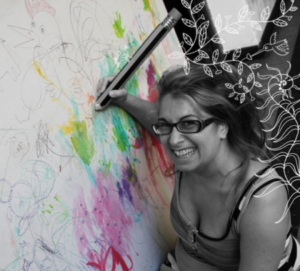
Inspiring images and engaging text walk hand-in-hand in memorable picture books. A small percentage of these children’s books are created by one individual who creates both the story and the pictures. In most instances, artists create images after publishers accept an author’s text. Noteworthy, illustrators are able to successfully capture the tone and content of each author’s words. Extraordinary picture books highlight the talents of both the author and the illustrator.
Right before Passover, I reviewed a handful of new books, including a board book titled Alligator Seder. Today, I am introducing Elissambura, the illustrator for this adorable preschool board book. As you scroll through this interview, you will find information about her background as well as some of her unique methods.
Did you discover your artistic passions when you were a child or later?
I come from a family of artists. My father is a painter and my mother is a sculptor. What I least wanted to be as a child was to be an artist like my parents. I loved to paint and draw but I really dreamed of being a veterinarian who could heal huge animals in Africa.
Today, my dream is to know the savanna and the African jungle and to draw it.
Does your present work resemble your earlier work or has your style changed over time?
My work always changes. In each book and each project, something new appears. For example, a character, an eye shape, a setting, a way of painting, or a texture. Each project is unique and requires different things. If I wasn’t flexible and always changing, it would be very boring!
When and where did you receive your formal training to be an artist?
I studied as a professional illustrator at the Martin Malharro Higher School of Visual Arts, in the city of Mar del Plata, Argentina. I obtained my degree in 2000. While working as an artist, I continue to take courses, seminars, and workshops. This is a profession in which it is not possible to stop learning. I always have something new to discover.
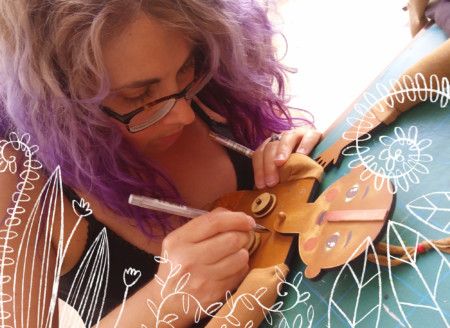
Did your formal training hinder your creativity or contribute to your evolving style?
Formal training is necessary to maintain creativity. It is the frame of reference from which an artist starts moving. If there is no formal training in terms of drawing, techniques, art history, visual language, etc., no one has rules to break. My formal training offers networking opportunities that support me when I jump into unfamiliar realms with innovative ideas. Keep in mind that one does not obtain a university degree to “learn to do something.” Instead, education provides tools that enable people to learn skills for future use. Universities can´t teach everything during the duration of a program.
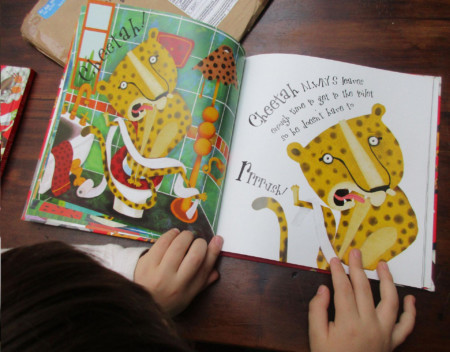
Does your South American culture influence your work?
Yes, I think so. Our culture influences us in everything we do, from developing an illustration to how we read a story or how we greet.
When and why did you decide to become an illustrator?
As a child, I was attracted to images, stories, animals, letters, the scent of ink, paper, books, materials, and learning new things. Above everything else, I loved using my imagination. But since my parents were artists as well as teachers in art school, being an illustrator was not my first option.
First, I wanted to be a veterinarian. I started studying biology and also took other science courses. When asked to dissect a live toad, I left this field of study and never came back.
Since I like reading, I started my degree in letters. I spent a year reading books that I didn’t like. I wanted to use my imagination while reading science fiction and fantasy books. My required reading didn’t include Tolkien, Stephen King, Christine Nöstlinger, or Roald Dahl.
I eventually started art school with the idea of studying design. While pursuing this course of study, I discovered a career in illustration. I fell in love with this profession. Now I can draw animals, imaginary images, tell stories, research, and learn new things with each project.
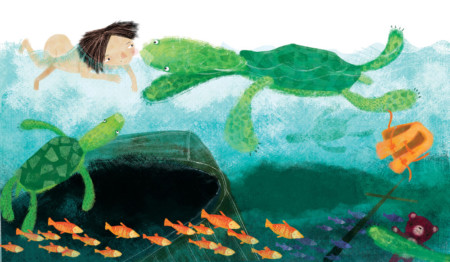
To date, how many books have you illustrated and how many are available in the North American market?
I have illustrated approximately two dozen books and more textbooks. Four books are written in English for the US market and one is in Spanish and Braille. I will be publishing two more books in English next year.
Are your illustrations primarily geared towards board books, or do you also create illustrations for picture books for older children?
My work focuses on creating illustrations for children’s and youth books.
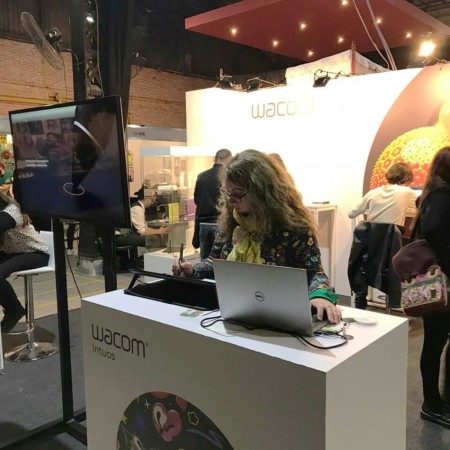
Do you prefer an artistic technique or do you use a variety of methods?
I love working with mixed techniques, mixing traditional materials such as acrylics, waxes, pencils, or watercolors with digital techniques, and achieving images that are not well-known methods.
To better understand, I will share the step by step illustrations for Alligators Seder. After I have all the approved sketches, I start with the pre-production of the illustrations.
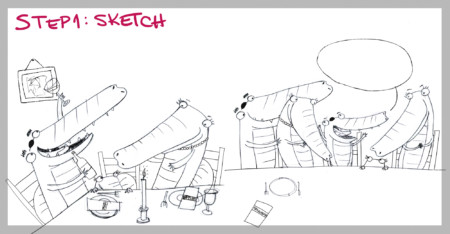
In the second step, I prepare different textures and details such as hair, skin, or fabric. Next, I paint on papers with different traditional materials. In the pictures with the alligators, I used watercolor for alligators’ skin, the grass, walls, and the house.
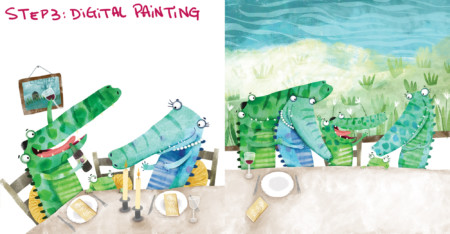
In addition to working with regular digital brushes, I have developed my own brushes which provide a personal touch.
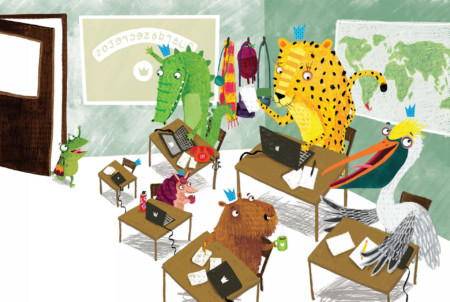
Animals are a prominent topic. Why?
I love animals from around the world. The diversity of species is fascinating to me and they are beautiful and fun to draw. However, animals are not the only thing I draw. Animals appear often in my work because publishers really like my animals. The most popular request is to draw animal books
When creating illustrations for picture books, do you have any direction from the author and / or publisher? Are you free to interpret the images that bring the text to life?
Sometimes publishers send the text in the body of an email or in a text file. They determine the number of pages and the size of the book. I decide on the rest.
Other times, I am given very specific instructions. I am told what to draw on each page, including the details like the format and the colors.
Occasionally, I am merely sent the text and blank spaces where I am free to decide what to draw, what characters to do, and how to set the scenes.
Have you ever had a situation where your illustrations do not match the expectations of the author or publisher?
Yes, more than once. But it was because they liked it more than they had imagined at first. Hahaha.
How much time do you usually spend creating illustrations for a picture book?
It also depends on the project. Some books demand a tight schedule and others take many months of going back and forth.
At this moment I am finishing two books. I completed the first book within two months. I have been working on the second book for more than a year and a half. The process has gone back and forth as my sketches are returned for corrections.
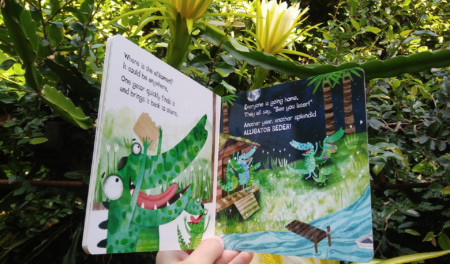
Alligator Seder includes many Jewish symbols. Were you familiar with the Passover holiday or did you need to research the holiday before creating the images?
No, I was not familiar with Passover. My love of learning inspired the investigative process. My editor, Joni Sussman from Kar-Ben, helped by sending photos, texts, and specific material on the subject.
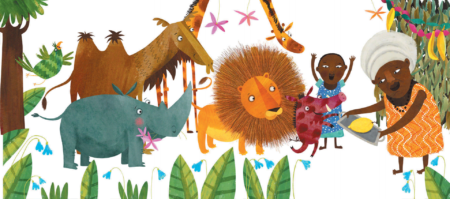
Are you pursuing other artistic endeavors?
My artistic life is focused on “saying things” using my creative illustration in different platforms— children’s books, the general publishing market, teaching illustrations at workshops for children and adults, urban interventions, and the production of illustrated objects.
Elissambura’s work can be viewed on her website and on Instagram— @Elissambura.
Question for Readers
Do you have a favorite picture book illustrator that you’d like to see interviewed? Please share in the comment section below.
Let me introduce you to some more picture books:
Two Passover Picture Books by Lesléa Newman
BIO
Sandra Bornstein is the author of May This Be the Best Year of Your Life. Sandra’s memoir highlights her living and teaching adventure in Bangalore, India. She was a licensed Colorado teacher who taught K-12 students in the United States and abroad as well as college-level courses. In addition to reviewing books and interviewing authors, Sandra is a freelance lifestyle and travel writer. Many of Sandra’s stories appear on the For Readers page. Additional stories can be read on TheTravelingBornsteins website.
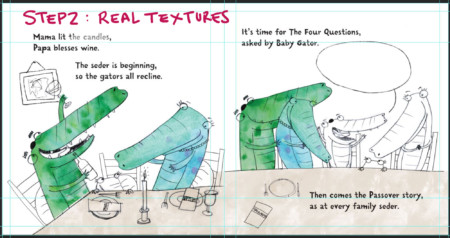
Connect with Sandra